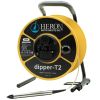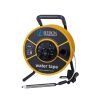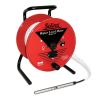Heron dipper-Tough Water Level Meters
Features
- Fully pressure/depth rated 5/8" probe
- Hydrocarbon-resistant, Kynar jacketed steel core tape
- Includes padded carry case with tape guide and hanger
- Free ground shipping
- Expedited repair and warranty service
- Lifetime technical support
- More
Overview
The Heron dipper-Tough Water Level Meter is a rugged, top-quality instrument used for measuring static and falling head levels in waste disposal and remediation sites and other harsh environments. The drawDown feature on the dipper-Tough makes this unit ideal to use during pump and treat testing when contaminates are found in the groundwater. The hydrocarbon-resistant Kynar jacketed, high tensile steel core tape is embedded directly into the probe body, allowing for a longer life of the tape and probe.
Benefits
- Electronic Module (IP65): Mode selectable for static and drawDown levels, removable for easy cleaning and servicing
- Probe (IP68): Fully pressure/depth rated 5/8”
- Steel Tape: High tensile steel, jacketed with Kynar, high break strength, stretch resistant and lifelong legibility – markings in engineering scale (1/100’) or metric (mm)
- Padded Carry Case: Protects the precision water level meter from the elements
- Tape Guide and Hanger: Supports the meter at the well head and protects the tape from sharp edges on the well casing
- Vinyl Holding Grip: Molded to the frame, ergonomic easy grip
- Winding Handle: Custom-made for easy rewinding with gloved hands
- Premium Stainless Steel Kynar Coated Tape
- 5/8” (15.9mm) Water Level Probe (IP68) w/ holder
- Electronic Panel with audio and visual signals (Fully Encapsulated to IP65)
- Sensitivity dial
- Vinyl, ergonomic holding grip
- 9V Battery
- Backpack Carrying Case w/ adjustable straps, laptop & notepad pouches
In The News
Spring 2025 Environmental Monitor Available Now
In the Spring 2025 edition of the Environmental Monitor, we highlight partnerships across the world and the importance of collaboration between government agencies, universities, environmental groups, local communities, and other stakeholders. From great white shark research in Cape Cod to monitoring fisheries in Lake Erie, this latest edition underscores partnerships that connect stakeholders in a watershed through environmental data. With an emphasis on data sharing, a combination of real-time and discrete sampling keeps the public and partners informed of environmental conditions. Our writers also sought out science professionals dedicated to working with peers within and outside of the environmental sector.
Read MoreMonitoring Mariculture in the Gulf of Alaska
The mariculture industry in the Gulf of Alaska has been steadily growing in recent years, guided by ongoing research to help refine farm location and cultivation practices. A subset of aquaculture, mariculture focuses on rearing organisms in the open ocean. In Alaska, finfish farming is illegal, so most farms cultivate kelp, oysters, or a combination of the two. These small, locally operated farms started popping up in the Gulf of Alaska in the early 1990s, when shellfish farming first became legal. Kelp farming did not begin to catch on in the state until 2016. Many of the coastal areas that have grown interested in mariculture are historically commercial fishing communities.
Read MoreSupplying Seattle’s Drinking Water: Using Data Buoys to Monitor the Cedar River Municipal Watershed
Providing clean, safe, and reliable drinking water for the 1.6 million people in the greater Seattle area is a top priority for Seattle Public Utilities (SPU). With limited water supplies, SPU dedicates considerable resources to maintain its watersheds and mountain reservoirs. About 70 percent of Seattle Water comes from the Cedar River Municipal Watershed , and the other 30 percent comes from the South Fork Tolt River Watershed . [caption id="attachment_39574" align="alignnone" width="940"] Data buoy in Chester Morse Lake . (Credit: Kevin Johnson / Seattle Public Utilities) [/caption] Jamie Thompson, a fisheries biologist at SPU, monitors aquatic ecosystems centered on fish listed under the U.S. Endangered Species Act (ESA).
Read More






















